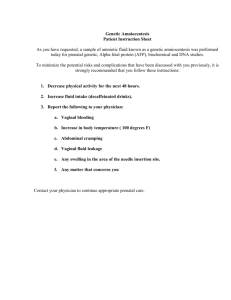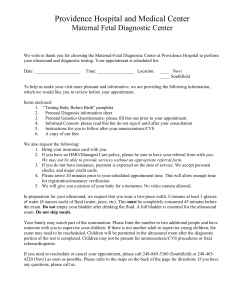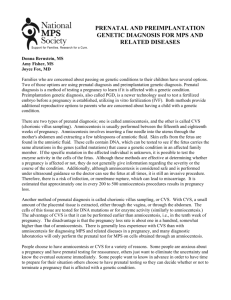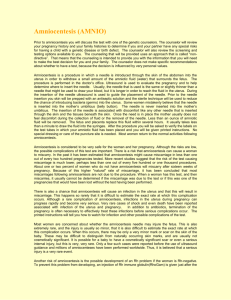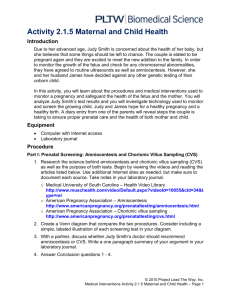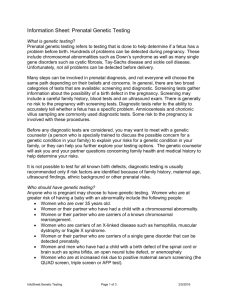The Outcome of Amniocentesis at 14 Weeks of Gestation
advertisement
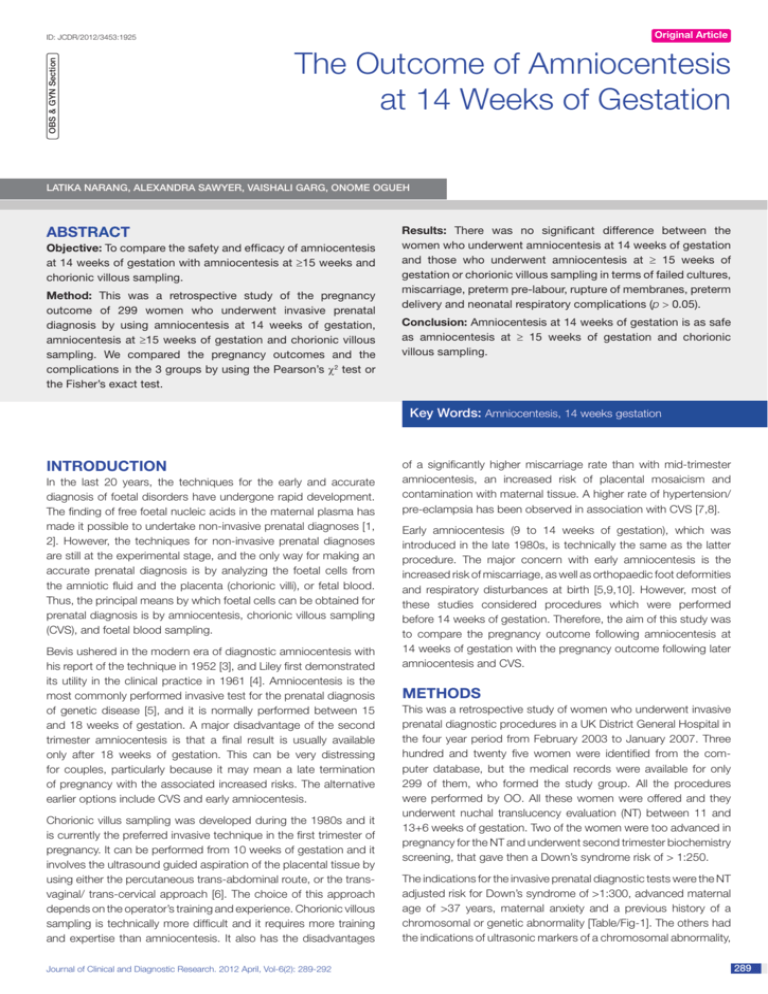
Original Article OBS & GYN Section ID: JCDR/2012/3453:1925 The Outcome of Amniocentesis at 14 Weeks of Gestation Latika Narang, Alexandra Sawyer, Vaishali Garg, Onome Ogueh ABSTRACT Objective: To compare the safety and efficacy of amniocentesis at 14 weeks of gestation with amniocentesis at ≥15 weeks and chorionic villous sampling. Method: This was a retrospective study of the pregnancy outcome of 299 women who underwent invasive prenatal diagnosis by using amniocentesis at 14 weeks of gestation, amniocentesis at ≥15 weeks of gestation and chorionic villous sampling. We compared the pregnancy outcomes and the complications in the 3 groups by using the Pearson’s χ2 test or the Fisher’s exact test. Results: There was no significant difference between the women who underwent amniocentesis at 14 weeks of gestation and those who underwent amniocentesis at ≥ 15 weeks of gestation or chorionic villous sampling in terms of failed cultures, miscarriage, preterm pre-labour, rupture of membranes, preterm delivery and neonatal respiratory complications (p > 0.05). Conclusion: Amniocentesis at 14 weeks of gestation is as safe as amniocentesis at ≥ 15 weeks of gestation and chorionic villous sampling. Key Words: Amniocentesis, 14 weeks gestation Introduction In the last 20 years, the techniques for the early and accurate diagnosis of foetal disorders have undergone rapid development. The finding of free foetal nucleic acids in the maternal plasma has made it possible to undertake non-invasive prenatal diagnoses [1, 2]. However, the techniques for non-invasive prenatal diagnoses are still at the experimental stage, and the only way for making an accurate prenatal diagnosis is by analyzing the foetal cells from the amniotic fluid and the placenta (chorionic villi), or fetal blood. Thus, the principal means by which foetal cells can be obtained for prenatal diagnosis is by amniocentesis, chorionic villous sampling (CVS), and foetal blood sampling. Bevis ushered in the modern era of diagnostic amniocentesis with his report of the technique in 1952 [3], and Liley first demonstrated its utility in the clinical practice in 1961 [4]. Amniocentesis is the most commonly performed invasive test for the prenatal diagnosis of genetic disease [5], and it is normally performed between 15 and 18 weeks of gestation. A major disadvantage of the second trimester amniocentesis is that a final result is usually available only after 18 weeks of gestation. This can be very distressing for couples, particularly because it may mean a late termination of pregnancy with the associated increased risks. The alternative earlier options include CVS and early amniocentesis. Chorionic villus sampling was developed during the 1980s and it is currently the preferred invasive technique in the first trimester of pregnancy. It can be performed from 10 weeks of gestation and it involves the ultrasound guided aspiration of the placental tissue by using either the percutaneous trans-abdominal route, or the transvaginal/ trans-cervical approach [6]. The choice of this approach depends on the operator’s training and experience. Chorionic villous sampling is technically more difficult and it requires more training and expertise than amniocentesis. It also has the disadvantages Journal of Clinical and Diagnostic Research. 2012 April, Vol-6(2): 289-292 of a significantly higher miscarriage rate than with mid-trimester amniocentesis, an increased risk of placental mosaicism and contamination with maternal tissue. A higher rate of hypertension/ pre-eclampsia has been observed in association with CVS [7,8]. Early amniocentesis (9 to 14 weeks of gestation), which was introduced in the late 1980s, is technically the same as the latter procedure. The major concern with early amniocentesis is the increased risk of miscarriage, as well as orthopaedic foot deformities and respiratory disturbances at birth [5,9,10]. However, most of these studies considered procedures which were performed before 14 weeks of gestation. Therefore, the aim of this study was to compare the pregnancy outcome following amniocentesis at 14 weeks of gestation with the pregnancy outcome following later amniocentesis and CVS. Methods This was a retrospective study of women who underwent invasive prenatal diagnostic procedures in a UK District General Hospital in the four year period from February 2003 to January 2007. Three hundred and twenty five women were identified from the com­ puter database, but the medical records were available for only 299 of them, who formed the study group. All the procedures were performed by OO. All these women were offered and they underwent nuchal translucency evaluation (NT) between 11 and 13+6 weeks of gestation. Two of the women were too advanced in pregnancy for the NT and underwent second trimester biochemistry screening, that gave then a Down’s syndrome risk of > 1:250. The indications for the invasive prenatal diagnostic tests were the NT adjusted risk for Down’s syndrome of >1:300, advanced maternal age of >37 years, maternal anxiety and a previous history of a chromosomal or genetic abnormality [Table/Fig-1]. The others had the indications of ultrasonic markers of a chromosomal abnormality, 289 Latika Narang et al., The Outcome of Amniocentesis at 14 Weeks of Gestation a second trimester biochemistry Down’s syndrome screening risk of > 1:250 and exposure to chickenpox. The complications of invasive prenatal testing and pregnancy outcome as was compared between the 3 groups, included failed procedures, failed cultures, amniotic fluid leakage, blood stained liquor, vaginal bleeding, miscarriage within 1 week of the procedure, miscarriage at < 24 weeks of gestation, preterm, pre-labour rupture of the membranes, preterm delivery and neonatal respiratory complications. Statistical analysis was performed by using SPSS, version 15.0. The three groups of women were compared by using the Pearson χ² test or the Fisher’s exact test when the conditions for the former were not met. When a significant difference was found in the tables, the categories which were responsible for the association were determined by the analysis of the standardized residuals. For all the analyses, a p value of equal to 0.05 was used as the limit of the statistical significance. Results Of the 299 women that formed the study population, 130 (43%) underwent CVS, 93 (32%) underwent amniocentesis at 15 weeks, and 76 (25%) women underwent amniocentesis at 14 weeks. [Table/Fig-1] lists the demographic and the obstetric characteristics of the study population. The main reason for having an invasive procedure for the whole group was advanced maternal age (43%) and NT risk 1:300 (35%). There was a significant difference between the groups in terms of the indications for prenatal testing χ² (8) = 40.12, p <.001. The inspection of the standardized residuals indicated that women who had their procedure because their NT risk was > 1:300 were overrepresented in the CVS group, and underrepresented in the later amniocentesis group. Women who requested their procedure because of anxiety but had no other www.jcdr.net indication for the invasive testing were overrepresented in the amniocentesis at 15 weeks group. However, the groups showed no difference in terms of the maternal age, parity, previous miscarriage and placental localization (p > .05). The complications of the procedures and the outcome of the pregnancy are presented in [Table/Fig-2]. Chromosomal abnor­ malities were identified in 19 cases (6.4%), 17 by CVS and the other two by amniocentesis at 14 weeks of gestation. No chromosomal abnormality was identified in the group that had amniocentesis at ≥ 15 weeks of gestation. The difference between the groups was significant χ² (2) = 17.67, p <.001. The standardized residuals indicated that women who underwent CVS had more chromosomal abnormalities than were expected, and that the women in the amniocentesis at 15 weeks group had fewer abnormalities than were expected. There were no cases of early miscarriage (within one week of the procedure) in any of the three groups. With regards to the miscarriages up to 24 weeks of gestation, 1 occurred in women who had amniocentesis at ≥ 15 weeks of gestation, two in women who had CVS, and no miscarriages occurred in women who had amniocentesis at 14 weeks of gestation. The difference between the groups was not statistically significant, and the overall pregnancy loss in this study population was 1.03% (3/292). No information was available for 7 women following the procedure. There was also no significant difference between the three pro­ cedures in terms of culture failures, vaginal bleeding, amniotic fluid leakage, PPROM, preterm delivery and early neonatal respiratory complications (p > .05). There was also no significant difference between the two amniocentesis groups in terms of occurrence of blood stained fluid (p > .05). Two failed procedures occurred in the CVS group. There were no cases of IUFD/SB in any of the three diagnostic test groups. Amniocentesis 14 N = 76 Amniocentesis ≥15 N = 93 CVS N = 130 N % n % n % ≤ 20 0 0.0 0 0.0 2 1.5 20-29 5 6.6 6 6.5 19 14.6 30-39 47 61.8 53 57.0 69 53.1 ≥ 40 yrs Age 24 31.6 34 36.5 40 30.8 Parity 0 26 34.2 35 37.6 50 38.5 1+ 50 65.8 58 62.4 80 61.5 0 55 72.4 69 74.2 88 67.7 1 8 10.5 16 17.2 22 16.9 ≥ 1 13 17.1 7 7.6 20 15.4 Anterior 36 48.0 41 45.1 71 55.0 Posterior 37 49.3 46 50.5 54 41.9 Other fundal 2 2.7 4 4.4 4 3.1 NT risk > 1:300 23 30.3 18 19.6 63 48.5 Maternal age 39 51.3 42 45.7 46 35.4 Maternal anxiety 9 11.8 20 21.7 9 6.9 Previous history 5 6.6 6 6.5 12 9.2 Other 0 0.0 6 6.5 0 0.0 Previous miscarriage Placental site Indication [Table/Fig-1]: Characteristics of Women Undergoing Invasive Prenatal Diagnosis Procedures 290 Journal of Clinical and Diagnostic Research. 2012 April, Vol-6(2): 289-292 www.jcdr.net Latika Narang et al., The Outcome of Amniocentesis at 14 Weeks of Gestation Amniocentesis 14 weeks N = 76 n % Amniocentesis ≥15 weeks N = 93 CVS N = 130 n % n % Significance Failed procedure 0 0.0 0 0.0 2 0.7 ns Failed culture 1 1.4 0 0.0 0 0.0 ns Amniotic fluid leakage 0 0.0 1 1.1 0 0.0 ns Blood stained liquor 6 8.1 6 6.5 0 0.0 ns Bleeding 2 2.8 3 3.3 2 1.6 ns Miscarriage (1 week) 0 0.0 0 0.0 0 0.0 - Miscarriage (<24 weeks) 0 0.0 1 1.1 2 1.6 ns Preterm delivery 2 2.8 3 3.4 4 3.3 ns PPROM 0 0.0 2 2.3 1 0.8 ns Respiratory complication 2 2.8 3 3.4 2 1.6 ns IUFD/SB 0 0.0 0 0.0 0 0.0 - Karyotype (abnormal) 2 2.6 0 0.0 17 13.1 p = .00 [Table/Fig-2]: Pregnancy Outcomes According to Prenatal Diagnosis Procedure Note. CVS = Chorionic villus sampling, IUFD/SB = In utero foetal demise/still birth PPROM = Premature rupture of the membranes. Discussion There is limited evidence on the outcome of amniocentesis, spe­ cifically at 14 weeks of gestation. Roper et al., [11] in a review of 2924 amniocenteses, reported that the miscarriage rates varied with the gestational age at which the procedure was performed, and that the total miscarriage rate was 1.0 percent after early amniocenteses (11 + 0−14 + 6 weeks), 1.2 per cent after traditional mid-trimester amniocenteses (15 + 0−18 + 6 weeks) and 3.1 percent for amnio­centeses which were performed after 18 + 6 weeks of gestation [11]. The cumulative miscarriage risk increased from 0.03 % at one week after the procedure to a plateau of 1.1%, five weeks after the procedure [11]. The preterm delivery and the stillbirth rates following the amniocenteses were similar in the early and traditional mid-trimester amniocenteses, but they were significantly higher when the amniocenteses were performed after 19 weeks of gestation, although the incidence of the talipes equinovarus was higher after early amniocentesis as compared to the traditional mid-trimester amniocenteses (1.4 percent versus 0.2 percent). None of the affected infants required corrective surgery [11]. In a 10 year study of 3769 amniocenteses, Centini and colleagues found that the amniocenteses which were performed at 13 and 14 weeks gestation were comparable to the later amniocenteses in terms of miscarriage, bloodstained amniotic fluid, failed cell cultures, amniotic fluid leakage, the preterm, premature rupture of the membranes (PPROM), preterm delivery and the presence of neonatal talipes equinovarous [5]. In the present study, there was no case of early post procedural miscarriage and the overall pregnancy loss rate was 1.03%. Although no pregnancy loss occurred following amniocentesis at 14 weeks of gestation, this was not statistically different from the later amniocentesis and the CVS groups. Blackstone and colleagues conducted a study to determine the rates of the complications which were associated with amniocentesis, based on the gestational age and found that the 12.0−12.9−week group had a complication rate of 1.20% (3/256), the 13.0−13.9−week group had the highest complication rate of 2.68% (8/298, P < 0.01), the 14.0−14.9−week group had the lowest complicate rate of 0.5% (1/183, P < 0.01), and that the 15.0−15.9−week group had a complication rate of 1.20% (2/166) [12]. The finding of the lowest incidence of the pregnancy Journal of Clinical and Diagnostic Research. 2012 April, Vol-6(2): 289-292 complications in the 14.0−14.9−week group was also consistent with the findings of this study, that the pregnancy outcome for women who had amniocentesis at 14 weeks of gestation was similar to those of women who had later amniocentesis and CVS. However, our sample size may have been insufficient to demonstrate any differences in the complication rate. In a long term follow up study, Schaap and colleagues matched 1509 women with a singleton pregnancy, who had transcervical CVS by age and season of conception with 1509 women with singleton pregnancies who had amniocentesis during 1985−1991 for an advanced maternal age of >35 years and they looked at the pregnancy outcome including congenital malformations, neonatal and paediatric morbidity and complications of motor development, speech, hearing and visual function which was obtained by a questionnaire in 1993−1995 and found no difference between the infants after CVS as compared to the infants after amniocentesis [13]. There was a significant difference between the groups in terms of the indication for invasive testing. This difference was because proportionately more CVS was performed for an NT risk of >1:300 as a higher risk of the chromosomal abnormality meant that women wanted an earlier test and hence they opted for CVS. Because the higher risk women mostly had CVS, 17 out of the 19 chromosomal abnormalities occurred in the CVS group. The other two occurred in the 14 weeks amniocentesis group. In conclusion, although the evidence regarding the safety of amniocentesis specifically at 14 weeks of gestation is scanty it appears to be no different from later amniocentesis and CVS. We found no difference in the pregnancy outcome in women who had amniocentesis at 14 weeks of gestation as compared to later amniocentesis or CVS. Thus, amniocentesis at 14 weeks of gestation could be offered to the women as an alternative to later amniocentesis or CVS without a significantly increased risk for both the mother and the baby. Indeed, performing amniocentesis at 14 weeks of gestation will avoid the technical difficulties of CVS and reduce the distress which is associated with waiting for a later amniocentesis and the increased risks of a late termination of pregnancy. 291 Latika Narang et al., The Outcome of Amniocentesis at 14 Weeks of Gestation References [1] Avent ND, Madgett TE, Maddocks DG, Soothill PW.Cell-free fetal DNA in the maternal serum and plasma: current and evolving applications. Current Opinion in Obstetrics and Gynecology. 2009;21:175-79. [2] Tong YK, Jin S, Chiu RW, Ding C, Chan KC, Leung TY, et al. Noninvasive prenatal detection of trisomy 21 by an epigenetic-genetic chromosome-dosage approach. Clinical Chemistry. 2010; 56:90-98. [3] Bevis DSA. The antenatal prediction of hemolytic disease of the newborn. Lancet 1952, 1:395. [4] Liley AW. Liquor amnii analysis in the management of the pregnancy complications by rhesus sensitization. AM J Obstet Gynaecol 1961; 82: 13-59. [5] Centini G, Rosignoli L, Kenanidis A, Scarinci R, Petraglia F. A report of early (13 + 0 to 14 + 6 weeks) and mid-trimester amniocenteses: 10 years of experience. Journal of Maternal-Fetal and Neonatal Medicine. 2003;14:113-17. [6] A Alfirevic Z, Sundberg K, Brigham S. Amniocentesis and chorionic villus sampling for prenatal diagnosis. Cochrane Database of Systematic Reviews. 2003;(3):CD003252. [7] Amniocentesis and chorionic villous sampling RCOG (Green-top 8) Guideline. 2005. [8] Silver RK, Wilson RD, Philip J, Thom EA, Zachary JM, Mohide P, et al. Late first-trimester placental disruption and subsequent AUTHOR(S): 1. 2. 3. 4. Dr. Latika Narang Ms. Alexandra Sawyer Dr. Vaishali Garg Dr. Onome Ogueh PARTICULARS OF CONTRIBUTORS: 1. MRCOG; Brighton and Sussex University Hospitals NHS trust, 2. MSc; School of Psychology; University of Sussex, 3. MRCOG; Brighton and Sussex University Hospitals NHS Trust, 4. MRCOG; Brighton and Sussex University Hospitals NHS Trust, www.jcdr.net gestational hypertension/preeclampsia. Obstetrics and Gynecology. 2005;105:587-92. [9] Cederholm M, Haglund B, Axelsson O. Infant morbidity following amniocentesis and chorionic villus sampling for prenatal karyotyping. BJOG: An International Journal of Obstetrics and Gynaecology. 2005;112:394-402. [10] Tredwell SJ, Wilson D, Wilmink MA. Review of the effect of early amniocentesis on foot deformity in the neonate. Journal of Pediatric Orthopedics. 2001;21:636-41. [11] Roper EC, Konje JC, De−Chazal RC, Duckett DP, Oppenheimer CA, Taylor DJ Genetic amniocentesis: Gestation−specific pregnancy outcome and the comparison of the outcome following early and traditional amniocentesis. Prenatal diagnosis 1999;19:803−807. [12] Blackstone J, Pinette MG, Pan Y, Pinette SG, Michaud J. Is there an optimal time for early amniocentesis? Journal of Maternal−Fetal Investigation 1997;7:72−75. [13] Schaap AH, van der Pol HG, Boer K. Leschot NJ, Wolf H. Long-term follow-up of infants after transcervical chorionic villus sampling and after amniocentesis to compare the congenital abnormalities and the health status. Prenatal Diagnosis. 2002;22:598-604. NAME OF DEPARTMENT(S)/INSTITUTION(S) TO WHICH THE WORK IS ATTRIBUTED: Department of Obstetrics and Gynaecology Princess Royal Hospital, Brighton and Sussex University Hospital NHS Trust. NAME, ADDRESS, TELEPHONE, E-MAIL ID OF THE CORRESPONDING AUTHOR: Dr. Latika Narang; 158,Winkworth Road, Banstead, Surrey; SM7 2QT Phone: 07961055723 E-mail: latikaong@yahoo.co.uk Financial OR OTHER COMPETING INTERESTS: None. Date Of Submission: Oct 15, 2011 Date Of Peer Review: Dec 22, 2011 Date Of Acceptance: Jan 17, 2012 Date Of Publishing: Apr 15, 2012 292 Journal of Clinical and Diagnostic Research. 2012 April, Vol-6(2): 289-292
